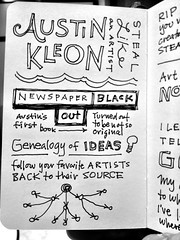If I was a cartoonist I would depict a cyberflâneur with huge burning ears… because s/he had developed the ability to listen intently from a place of silence! ~ Linda Hollier
Linda Hollier‘s (@lindahollier) playful caricature delights for many reasons not the least of which is its totally unselfconscious (and, I suspect, unintentional) counterpoint to Evgeny Morozov‘s (@evgenymorozov) op-ed, “The Death of the Cyberflâneur“.
Morozov pits his cyberflâneur caricature — a late 19th century dandy shackled and handcuffed between Facebook’s Mark Zuckerberg and Sheryl Sandberg — at odds with social media.

Transcending its original playful identity… [the Internet is] no longer a place for strolling — it’s a place for getting things done. Hardly anyone “surfs” the Web anymore. The popularity of the “app paradigm,”… has made cyberflânerie less likely…
THE tempo of today’s Web is different as well… the “real-time Web,”… it’s Silicon Valley’s favorite buzzword.
That’s no surprise: people like speed and efficiency… ~ Evgeny Morozov (NYTimes.com)
Morozov proceeds to single out Google and Facebook as two of the most flanerie-threatening forces. He likens the latter to Baron Haussmann who’s urban planning transformed Paris during the reign of Napoleon III, eliminating many of the conditions which had proven favorable to flâneurs.
Google, in its quest to organize all of the world’s information, is making it unnecessary to visit individual Web sites in much the same way that the Sears catalog made it unnecessary to visit physical stores several generations earlier.
[…]
Facebook seems to believe that the quirky ingredients that make flânerie possible need to go. “We want everything to be social,” Sheryl Sandberg, Facebook’s chief operating officer, said on “Charlie Rose” a few months ago. (NYTimes.com)
Swept up in a relentless 24×7 social data stream which simultaneously guides and limits our capacity (or appetite) for aimless meandering, we are less and less likely to veer from the pack. Gone is the autonomy and the veil of anonymity which let us lurk voyeuristically, dabbling, observing, studying humanity’s mesmerizing diversity. Or so Morozov asks us to believe.

Hollier offers another perspective. She isn’t Pollyannaish about the web, social media and our increasingly wired lifestyles, nor does she shy from the challenges of information overload. Instead she embraces the data inundation much as late 19th century Parisian flâneurs embraced the urban throng. Together, but apart.
It is this intentional distance that Hollier and I have mused over individually and collectively over the last year or two. We recently reflected on deep listening to access the source of storytelling, even in the midst of distraction and hubbub. Hollier has explored the flâneur as a model for mindfulness, suggesting that “the flâneur thus begins to play the role of consciousness“, and she returns to the idea of mindfulness in “Cyberflanerie: Deep Listening in Cyberspace“, suggesting that the state of conscious, unbiased receptivity is precisely what distinguishes and empowers cyberflâneurs.
There is so much information coming at us in cyberspace that unless we nurture the intention of listening with “moment by moment, non-judgmental awareness” – the definition of mindfulness given by Jon Kabat-Zinn – we stand the risk of being overwhelmed and suffering from information overload. We will fail to capture the fleeting moment. It is only with an attitude of deep listening that we will be able to filter what really needs our attention. (here2here)
Deep listening. The cyberflâneur’s art, like his/her predigital forebears, is the art of receptivity. Attentive openness and observation without judgment. Heightened perception and omnivorous curiosity.
Today as we move through the speedy spheres of cyberspace – the limitless mindspace we find ourselves in when using technology to communicate – I believe it is the perceptive attitude of the flaneur that we should seek to cultivate… This practice will require a deep listening, whether it be to visual, aural or textual images. (here2here)
Hollier’s big-eared caricature of a mindful cyberflâneur strolling the global arcades we know as the Internet and practicing the art of listening resonates with John Hendel‘s (@johnhendel) “The Life of the Cyberflâneur“.
Space, whether for the Parisian walker, Internet browser, or tablet user, always has its architects, and what we now have amounts to a virtual, wonderful labyrinth without end… The cyberflâneur is triumphantly alive, a wry cackling presence that pops up wherever I look… Lurkers quietly drift at all hours, intent and voyeuristically hungry for understanding. There’s the sly playfulness and quirk… The cyberflâneur continues to probe our online paths today, and I suspect the same will be true tomorrow. (The Atlantic)

Hendel’s article, penned as a response to Morozov’s doomsday op-ed, concludes with an inevitable observation: Morozov must be strolling another Internet. After all, the digital arcades that Hendel, Hollier and I stroll enable and encourage a veritable renaissance for flanerie. Long live the cyberflâneur!
If you’ve endured this ponderous post, you may enjoy reading the following related reflections:
Like this:
Like Loading...












